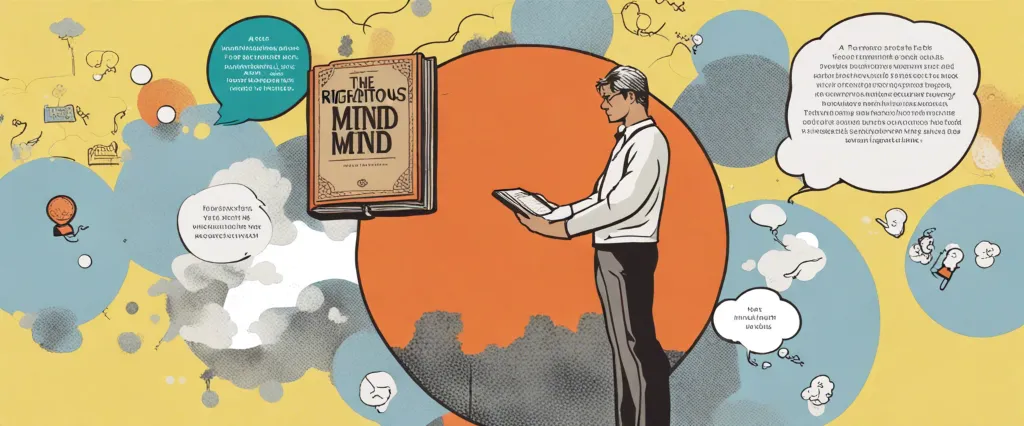
In today’s ever-evolving landscape of psychological literature, exploring the intricacies of human behavior and the intricate workings of the mind has become an increasingly crucial endeavor. Among the myriad texts that delve into this subject matter, two prominent works stand out for their comprehensive examination of the foundations of morality, human nature, and social behavior: “The Righteous Mind” by Jonathan Haidt and “The Social Animal” by Elliot Aronson.
“The Righteous Mind” by Jonathan Haidt presents an intricate examination of the moral and psychological dimensions that shape our political ideologies, shedding light on the deeper sources of human morality. Drawing upon an impressive array of scientific research, Haidt explores the innate nature of human moral judgments, dissecting the six moral foundations that he argues are universally shared across cultures. By engaging with Haidt’s work, readers gain an insightful understanding of the role of intuition and emotions in moral reasoning, challenging long-standing assumptions about the rationality of human decision-making.
On the other hand, “The Social Animal” by Elliot Aronson delves into the complexities of social influence and the interplay between individual behavior and the larger social context. Aronson’s book takes readers on a captivating journey through the realm of social psychology, illuminating the powerful forces that shape our thoughts, attitudes, and actions. By offering a wealth of real-life examples and captivating narratives, Aronson provides readers with a comprehensive framework for understanding the complexities of human behavior, navigating the realm of social influence with greater insight and awareness.
While both texts explore the depths of human nature and the intricate workings of the mind, they do so from distinct vantage points. Haidt’s “The Righteous Mind” primarily focuses on the role of morality and its influence on political ideologies, grounding his arguments in evolutionary psychology and neuroscience. In contrast, Aronson’s “The Social Animal” takes a broader approach, examining the interplay between individual behavior and the larger social context, often looking at social psychology experiments and theories.
In this comparative study, we will delve into the similarities and differences between these two foundational texts, exploring how they contribute to our understanding of human behavior, morality, and social influence. By examining the central themes, methodologies, and underlying theories of Haidt and Aronson’s works, we hope to shed light on the multifaceted nature of human behavior and the intricate workings of the mind in different contexts.
By extrapolating and integrating the insights shared by Haidt and Aronson, we aim to illuminate the intertwining threads of morality, social influence, and individual behavior, offering a comprehensive perspective on the complex tapestry that makes us human. Ultimately, understanding these intricacies is crucial in navigating the challenges of contemporary society, fostering empathy, and building bridges between divergent perspectives.
Brief Summary of Two Books
The Righteous Mind by Jonathan Haidt
“The Righteous Mind: Why Good People Are Divided by Politics and Religion” is a book by Jonathan Haidt that explores the moral psychology behind our political and religious differences. Haidt argues that these differences arise from the different moral foundations that individuals prioritize and how these foundations shape our beliefs and actions.
Haidt introduces the metaphor of our mind as an elephant and our conscious reasoning as its rider. He suggests that our moral intuitions often drive our actions, and our reasoning is often employed to justify those actions after the fact. He identifies six moral foundations that shape our moral judgments: care/harm, fairness/cheating, loyalty/betrayal, authority/subversion, sanctity/degradation, and liberty/oppression. Haidt explains how people on both the political left and right rely on different combinations of these moral foundations, leading to different moral worldviews.
In understanding these differences, Haidt also explores the concept of moral capital, which includes traits such as trust, loyalty, and social norms. He argues that societies require a balance of individualism and collectivism to thrive, and that relying too heavily on either can lead to polarization. Furthermore, he suggests that our moral intuitions are not solely shaped by rationality but are influenced by evolution and cultural factors.
Haidt also delves into how moral psychology can help us understand the nature of political and religious conflicts. He emphasizes the importance of empathy and understanding between individuals with different moral foundations and urges for a greater appreciation of moral diversity. Throughout the book, Haidt encourages readers to move beyond narrow-mindedness and engage in constructive dialogue that transcends our differences.
The Social Animal by Elliot Aronson
“The Social Animal” by Elliot Aronson is a renowned social psychology book that explores the complexities and influences shaping human behavior. The book takes readers on a captivating journey through the lives of a fictional couple, Harold and Erica, using their intertwined narrative to explain psychological principles and processes.
Aronson delves into various topics, including the power of social influence, the formation and impact of attitudes, the role of stereotypes and prejudices in shaping behavior, and the ways in which our unconscious mind affects our decision-making. He explains how our personal histories, social environments, and cultural backgrounds contribute to our understanding of ourselves and others.
Furthermore, the book delves into the importance of social connections and the impact of social support on our well-being. Aronson explores how individuals are heavily influenced by their social interactions and social norms, analyzing the impact of conformity, obedience, and group dynamics.
“The Social Animal” highlights the significance of empathy, compassion, and prosocial behavior in creating a more harmonious society. Aronson argues that understanding the social forces that shape us can lead to increased harmony, reduced conflict, and improved relationships.
Overall, through the captivating story of Harold and Erica, Aronson provides insights into social psychology theories and concepts, encouraging readers to critically analyze their own beliefs, behaviors, and motivations while offering guidance for creating a more empathetic and compassionate world.
Comparison between Two Books

Similarities in Social Psychology
The Righteous Mind by Jonathan Haidt and The Social Animal by Elliot Aronson are both highly regarded books in the field of social psychology. Although they approach the topic from different perspectives, there are several key similarities in their exploration of social psychology.
1. Emphasis on the importance of context: Both books stress the significance of considering the social and situational context in understanding human behavior. They argue that individual actions cannot be fully understood without taking into account the larger social, cultural, and environmental factors that shape behaviors and attitudes.
2. The role of emotion: Both authors recognize that emotions play a central role in social behavior and decision-making. They argue that emotional responses are often the underlying drivers of our thoughts and actions, influencing our moral judgments and interpersonal interactions.
3. Influence of perception and cognition: Both books delve into the ways in which our cognitive processes, including how we perceive and interpret information, can shape our social interactions. They explore how our biases, heuristics, and thought patterns influence our understanding of ourselves and others.
4. Moral reasoning and intuition: Haidt and Aronson both examine the interplay between moral reasoning and intuitive processes. They suggest that moral judgments are often derived from intuitions or gut feelings, rather than solely rational decision-making. They argue that understanding these intuitive processes is crucial to understanding moral and social behavior.
5. Self and identity: Both books explore the construction of self and identity within the social context. They investigate how social influences shape individuals’ self-perception, group identities, and sense of belonging. Additionally, they examine how these factors interact with moral frameworks and shape behaviors.
6. Application of social psychology to real-world issues: Both authors emphasize the practical implications of understanding social psychology. They discuss how the knowledge gained from social psychology research can be applied to improve various aspects of society, including politics, education, and interpersonal relationships.
Overall, The Righteous Mind and The Social Animal share common ground in their examination of social psychology, including contextual influences, the role of emotions, the impact of perception and cognition, moral reasoning and intuition, construction of self, and the application of social psychology to real-world issues. These books provide valuable insights into understanding human behavior and the social dynamics that shape our interactions.
Divergences in Social Psychology
The Righteous Mind by Jonathan Haidt and The Social Animal by Elliot Aronson are both highly influential books in the field of social psychology. While they share some commonalities, including a focus on human behavior and the impact of social influence, there are prominent divergences in their approaches and perspectives.
One significant divergence between these books lies in their emphasis on different aspects of social psychology. Haidt’s The Righteous Mind explores the moral foundations that underpin human behavior, delving deep into the evolutionary and cultural origins of morality. Haidt presents a comprehensive theory of moral psychology, arguing that our moral judgments are driven by six innate moral foundations – care, fairness, loyalty, authority, sanctity, and liberty. In contrast, Aronson’s The Social Animal provides a more holistic view of social psychology, covering a broad range of topics such as conformity, persuasion, attitudes, and prejudice. Aronson focuses on understanding how social forces shape individual thoughts, feelings, and behaviors, and he examines concepts such as cognitive dissonance and self-justification.
Another noteworthy divergence is the writing style and structure of the two books. Haidt’s The Righteous Mind has a more academic and scientific approach, offering extensive research and empirical evidence to support his arguments. It is structured in a manner that presents his moral foundations theory in a logical and systematic way. On the other hand, Aronson’s The Social Animal takes a more narrative-driven approach, weaving in real-life stories, case studies, and personal anecdotes. Aronson’s writing style creates a more accessible and engaging reading experience, which some readers may find more relatable and understandable.
Furthermore, the books differ in terms of the overall tone and perspective on human behavior. The Righteous Mind tends to adopt a more evolutionary and biological viewpoint, emphasizing the role of innate moral instincts and the adaptive advantages they confer on individuals and societies. It posits that moral judgments are not solely based on rational thinking but are influenced by intuitive and emotional processes. In contrast, The Social Animal takes a more social and situational perspective, highlighting the significant impact of social context on human behavior. Aronson emphasizes the power of social norms, group dynamics, and external influences in shaping our thoughts, attitudes, and actions.
In conclusion, while both The Righteous Mind by Jonathan Haidt and The Social Animal by Elliot Aronson contribute to the field of social psychology, they do so from different angles. Haidt focuses on the moral foundations that guide human behavior, while Aronson explores a broader range of social psychological phenomena. Their writing styles and perspectives also vary, with Haidt leaning towards an evolutionary perspective, and Aronson emphasizing social context and situational influences. As a result, readers interested in social psychology can benefit from exploring the unique insights and perspectives offered by each book.

Conclusion
Both “The Righteous Mind” by Jonathan Haidt and “The Social Animal” by Elliot Aronson are highly regarded books in the field of psychology and have been well-received by readers. However, the choice between them depends on individual interests and what specific aspects of human behavior and psychology one finds more intriguing.
“The Righteous Mind” explores the psychology of morality and why people differ in their ethical beliefs. Haidt delves into the foundations of morality, highlighting how emotions, intuition, and cultural biases influence our moral judgments. This book is ideal for those interested in understanding the psychological underpinnings of morality and politics.
On the other hand, “The Social Animal” by Elliot Aronson focuses on social psychology and how individual behavior is shaped by social influences. Aronson delves into topics such as conformity, self-justification, persuasion, and prejudice to provide insights into why people behave the way they do. This book is ideal for those fascinated by social dynamics and the impact of social factors on human behavior.
To determine which book is more worthy of reading for you, consider your specific interests and preferences. If you prefer understanding moral foundations and ethical differences, “The Righteous Mind” might be more suitable. However, if you are fascinated by social influences and how behaviors are shaped by social factors, “The Social Animal” could be the more engaging choice. Ultimately, both books offer valuable perspectives on human behavior and psychology, making either one worth reading depending on your interests.

